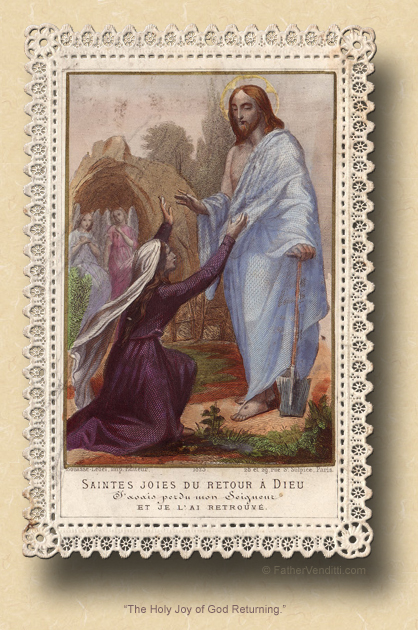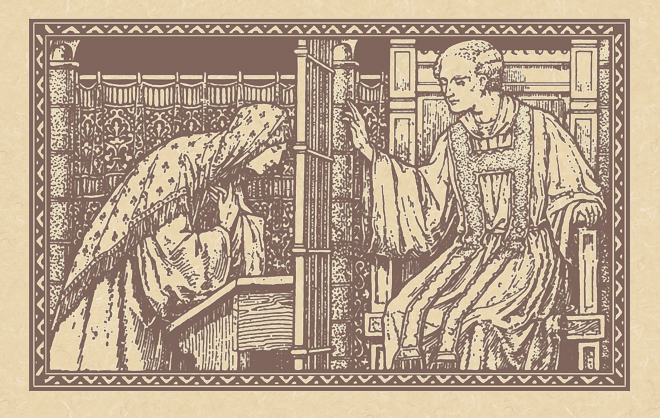Rest in Peace, George Carlin, If You Can.
The Feast of Saint Mary Magdalene.
Lessons from the proper, according to the ordinary form of the Roman Rite:
• Canticles 3: 1-4.
[or, II Corinthians 5: 14-17.]
• Psalm 63: 2-6, 8-9.
• John 20: 1-2, 11-18.
The Third Class Feast of Saint Mary Magdalene, Penitent.
Lessons from the proper, according to the extraordinary form of the Roman Rite:
• Canticles 3: 2-5; 8: 6-7.
• Psalm 44: 8, 3.
• Luke 7: 36-50.*
The Sixth Saturday after Pentecost; the Feast of the Holy Myrrh-Bearer Mary Magdalene, Equal to the Apostles; and, the Feast of the Translation of the Relics of the Holy Bishop & Martyr Phocas.
First & third lessons from the pentecostarion, second & fourth from the menaion for the Myrrh-Bearer, according to the Ruthenian recension of the Byzantine Rite:
• Romans 12: 1-3.
• I Corinthians 9: 2-12.
• Matthew 10: 37—11: 1.
• John 20: 11-18.
FatherVenditti.com
|
 10:25 AM 7/22/2017 — It's not uncommon—and you have have heard it, I'm sure—to hear a comedian introduce a stand-up routine by pointing out that he or she was raised as a Catholic, and therefore grew up with a sense of guilt. This, then, becomes the premise of a series of jokes—sometimes funny, mostly not—which usually ends up holding the Church and the Faith up to ridicule. The reason these jokes work is because of the wide-spread assumption, foisted on us by modern pop-psychology, that guilt is something bad, and that feeling guilty is, somehow, psychologically unhealthy. 10:25 AM 7/22/2017 — It's not uncommon—and you have have heard it, I'm sure—to hear a comedian introduce a stand-up routine by pointing out that he or she was raised as a Catholic, and therefore grew up with a sense of guilt. This, then, becomes the premise of a series of jokes—sometimes funny, mostly not—which usually ends up holding the Church and the Faith up to ridicule. The reason these jokes work is because of the wide-spread assumption, foisted on us by modern pop-psychology, that guilt is something bad, and that feeling guilty is, somehow, psychologically unhealthy.
Not only is there nothing wrong with guilt—not only is it not unhealthy to feel guilty when one has sinned—but, in the context of our relationship with God, it is absolutely essential. The premise that guilt is unhealthy is predicated on the presumption that there's no such thing as sin, but there is. The saint whose feast we celebrate today was one of the most important and outstanding disciples of our Lord, and would not have become such had she not felt guilt. Guilt, and the feelings of remorse that go with it, is responsible for the lives of the some of the greatest saints in the history of the Church, many of them martyrs. Guilt is the seedbed of conversion; without guilt we do not repent of our sins, and without repentance we don't grow in Grace.
Non-Catholics and Catholics poorly formed in their Faith see guilt as an enemy of happiness, but exactly the opposite is true. Learning to recognize our sins and confessing them breaks down the walls that impede our spiritual growth. The more we become conscious of sin in our lives, the more we become receptive to Grace, and the closer we grow to our Lord and to that final end which is the reason for our life on this earth. We examine our consciences regularly and confess our sins frequently because it keeps our souls cleansed in anticipation of death, but also because, by routinely stripping away the vestiges of even the smallest venial sins, the pathways of Grace are plowed clear of whatever would hinder our growth in holiness. What results is a kind of spiral upward into union with God: the more we reflect on our sins and confess them, the more we become sensitive to the presence of sin in our lives, and become aware of faults that we didn't even recognize as faults before. This is how ordinary people grow in Grace and become great saints.
Shun the notion of guilt and sin, and the process is reversed: we reserve confession only for the big mortal sins, we don't examine our consciences regularly, and we become desensitized to venial faults, with the result that we begin to make excuses even for mortal sins. Confession, then, becomes a burden that we endure when required at Easter time, and growth in Grace is practically impossible. We tumble into a downward spiral, beset by temptation at every turn, receiving little if any Grace from our reception of Holy Communion, and coming to view Christian living as a struggle rather than a joy.
The Gospel lesson for this feast of Saint Mary Magdalene does not present to us the story of her conversion and repentance, as you might expect, nor even of the exorcism of the demons which possessed her; instead, it shows us the fruits of it. Having embraced her guilt, motivated by it to change her life and devote her life to Christ, she was given a Grace that was denied even to the Apostles: she was the first to see the Risen Lord. There is a lesson for us in that: Grace comes only to those humble enough to know they need it.

* This is the Gospel of the woman caught in adultery washing the feet of our Lord in the home of Simon. Pope St. Gregory the Great was the first to identify the woman in Luke 7 with Mary Magdalene (cf. Homily 33 on the Gospels). While Scripture scholars will continue to debate the issue—and Protestants, for the most part, reject it—the identification has become integral to Catholic devotion to the Magdalene. The Ordo of the ordinary form of the Roman Rite for the Province of Newark says, explicitly, that this identification is "mistaken," but cites no source; certainly there is no definitive teaching from the Church on the subject after Pope Saint Gregory's identification, and even a near universal consensus of Scripture scholars would not constitute the teaching of the Church.
If, on the other hand, the opinion of the editors of the Ordo is to be considered normative (though it is unclear on what authority), then this homily is still applicable in and of itself, and certainly is if one celebrates according to the extraordinary form, in which Mary Magdalene is specifically classified as a penitent.
The story of the woman caught in adultery (John 8: 1-11) is found mostly in old Latin manuscripts of John's Gospel, and in different places, sometimes at the beginning of chapter 8 as in modern Bibles, sometimes after 7: 36 just prior to our Lord's discourse on the last day of Pentecost, and sometimes at the very end of the Gospel. A few manuscripts include it at the end of Luke 21 just before the beginning of the Passion narrative, or at the end of his Gospel after the resurrection. Though Luke is generally regarded as the author, it is clear that it was never an original part of either Gospel, but inserted later, probably because of the allusion to Jeremiah 17: 13. Nevertheless, the Catholic Church has always accepted it as canonical, and part of the Gospel of Saint John; Saint Jerome certainly did.
|

